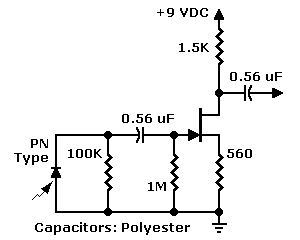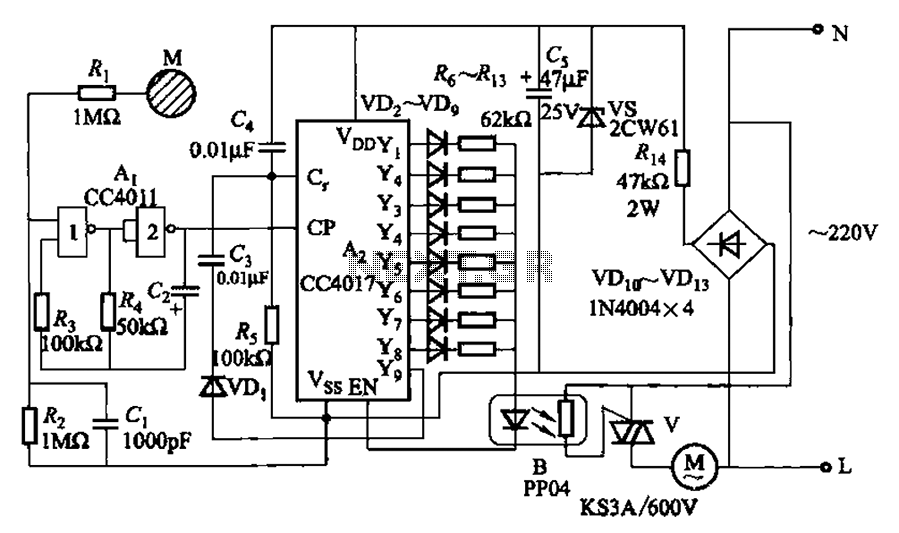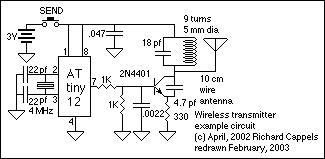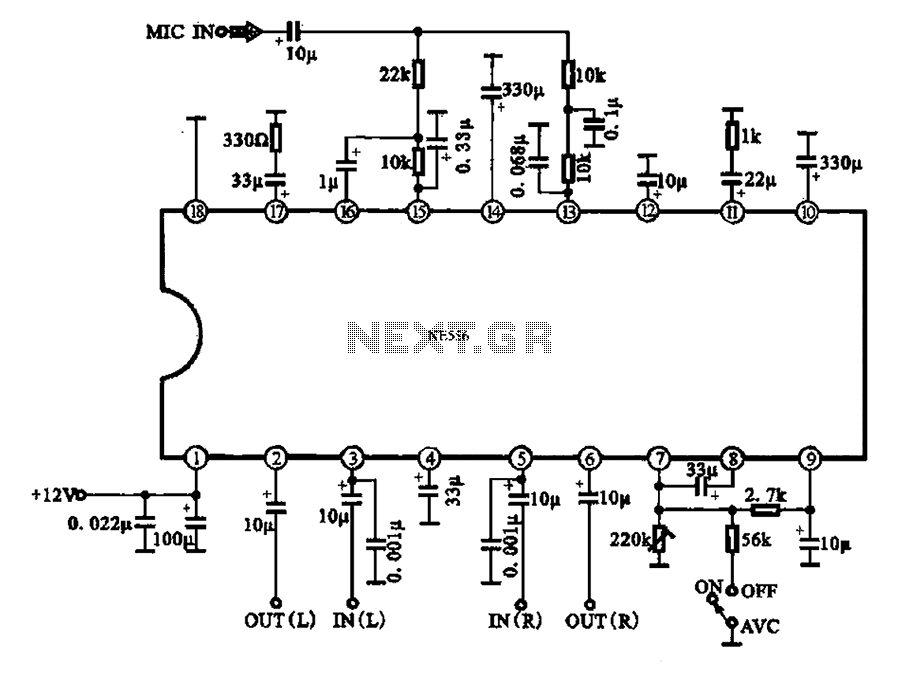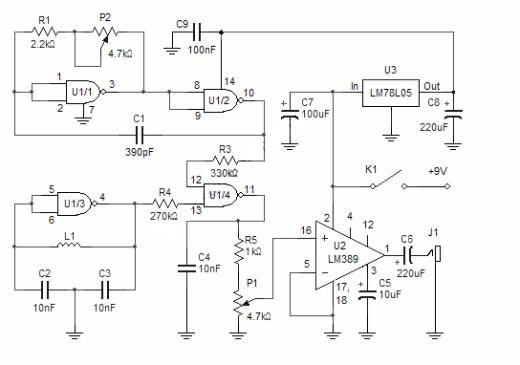
Beam-break Detector For Camera Shutter or Flash Control
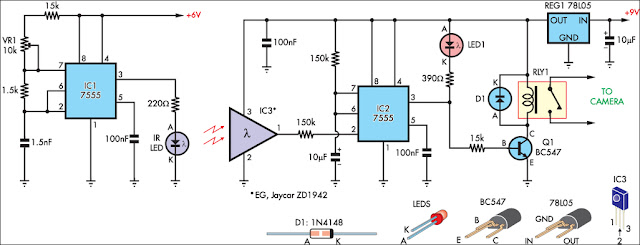
This circuit serves as an alternative to the infrared (IR) beam break detector featured in the June 2009 issue of Silicon Chip. It utilizes a standard IR receiver IC, such as the Jaycar ZD-1942, to minimize sensitivity to ambient light. The receiver outputs a high signal (5V) when a modulated beam is detected. The IR detector (IC3) controls an LM-7555 CMOS timer (IC2) operating in monostable mode. When the IR beam is interrupted, IC2 is triggered, causing its pin 3 output to go high for approximately half a second. This action extinguishes LED1 and activates transistor Q1, which drives a low-power 5V relay. Power for the circuit is supplied by six AA batteries and a 78L05 5V voltage regulator, which is essential for the operation of the receiver IC. The IR transmitter is also based on an LM-7555 (IC1), configured in astable mode with a low duty cycle. The frequency is calibrated to 38kHz using trimpot VR1. The IR diode used in the transmitter can be salvaged from an old remote control or purchased new. The transmitter is powered by four AA batteries. The system can operate over several meters and is designed to be insensitive to the alignment of the transmitter. However, the detection range can be narrowed by positioning the detector closer to the target object and/or employing a baffle to restrict the detection window.
This circuit is designed to provide a reliable and efficient method for detecting interruptions in an infrared beam, making it suitable for various applications such as security systems, automated doors, and object detection in robotics. The use of the Jaycar ZD-1942 IR receiver IC ensures that the circuit remains functional in environments with varying ambient light conditions, enhancing its versatility.
The monostable configuration of the LM-7555 timer allows for a predictable output duration, which is crucial for applications requiring a specific response time upon beam interruption. The output duration can be adjusted by changing the timing components associated with IC2, thus providing flexibility in response characteristics.
The low-power relay driven by transistor Q1 is capable of controlling larger loads, making this circuit suitable for activating alarms, lights, or other devices upon detection of an object. The choice of a 5V relay ensures compatibility with the power supply while maintaining energy efficiency.
The transmitter's astable mode configuration allows it to emit a continuous modulated IR signal, which is essential for the receiver to detect interruptions effectively. The 38kHz frequency is a standard choice for IR communications, as it minimizes interference from ambient light sources and other electronic devices.
In summary, this circuit offers a robust solution for infrared beam break detection, with a focus on reliability, flexibility, and ease of integration into various systems. The careful selection of components and configuration allows for effective operation in a range of environments and applications.This circuit is presented as an alternative to the IR beam break detector featured in the June 2009 issue (Silicon Chip). In order to make it relatively insensitive to ambient light, it uses a standard IR receiver IC such as the Jaycar ZD-1942.
This has a high output ( 5V) as long as a modulated beam is detected. The IR detector (IC3) controls an LM 7555 CMOS timer (IC2) which operates in mono stable mode. When the beam is broken, IC2 is triggered and its pin 3 output goes high for about half a second. This extinguishes LED1 and turns on transistor Q1 to drive a 5V low-power relay. The circuit is powered from six AA cells and a 78L05 5V regulator (necessary for the receiver IC). The IR transmitter is also built around an LM7555 (IC1), this time operating in astable mode at low duty cycle. Its frequency is set to 38kHz with trimpot VR1. The IR diode was salvaged from a defunct remote control but these are readily available new. The transmitter is powered by four AA cells. The system has a range of several metres and while it is insensitive to the transmitter alignment, the detection window can be narrowed by placing the detector near to the object to be detected and/or using some form of baffle to restrict the window.
🔗 External reference
This circuit is designed to provide a reliable and efficient method for detecting interruptions in an infrared beam, making it suitable for various applications such as security systems, automated doors, and object detection in robotics. The use of the Jaycar ZD-1942 IR receiver IC ensures that the circuit remains functional in environments with varying ambient light conditions, enhancing its versatility.
The monostable configuration of the LM-7555 timer allows for a predictable output duration, which is crucial for applications requiring a specific response time upon beam interruption. The output duration can be adjusted by changing the timing components associated with IC2, thus providing flexibility in response characteristics.
The low-power relay driven by transistor Q1 is capable of controlling larger loads, making this circuit suitable for activating alarms, lights, or other devices upon detection of an object. The choice of a 5V relay ensures compatibility with the power supply while maintaining energy efficiency.
The transmitter's astable mode configuration allows it to emit a continuous modulated IR signal, which is essential for the receiver to detect interruptions effectively. The 38kHz frequency is a standard choice for IR communications, as it minimizes interference from ambient light sources and other electronic devices.
In summary, this circuit offers a robust solution for infrared beam break detection, with a focus on reliability, flexibility, and ease of integration into various systems. The careful selection of components and configuration allows for effective operation in a range of environments and applications.This circuit is presented as an alternative to the IR beam break detector featured in the June 2009 issue (Silicon Chip). In order to make it relatively insensitive to ambient light, it uses a standard IR receiver IC such as the Jaycar ZD-1942.
This has a high output ( 5V) as long as a modulated beam is detected. The IR detector (IC3) controls an LM 7555 CMOS timer (IC2) which operates in mono stable mode. When the beam is broken, IC2 is triggered and its pin 3 output goes high for about half a second. This extinguishes LED1 and turns on transistor Q1 to drive a 5V low-power relay. The circuit is powered from six AA cells and a 78L05 5V regulator (necessary for the receiver IC). The IR transmitter is also built around an LM7555 (IC1), this time operating in astable mode at low duty cycle. Its frequency is set to 38kHz with trimpot VR1. The IR diode was salvaged from a defunct remote control but these are readily available new. The transmitter is powered by four AA cells. The system has a range of several metres and while it is insensitive to the transmitter alignment, the detection window can be narrowed by placing the detector near to the object to be detected and/or using some form of baffle to restrict the window.
🔗 External reference
